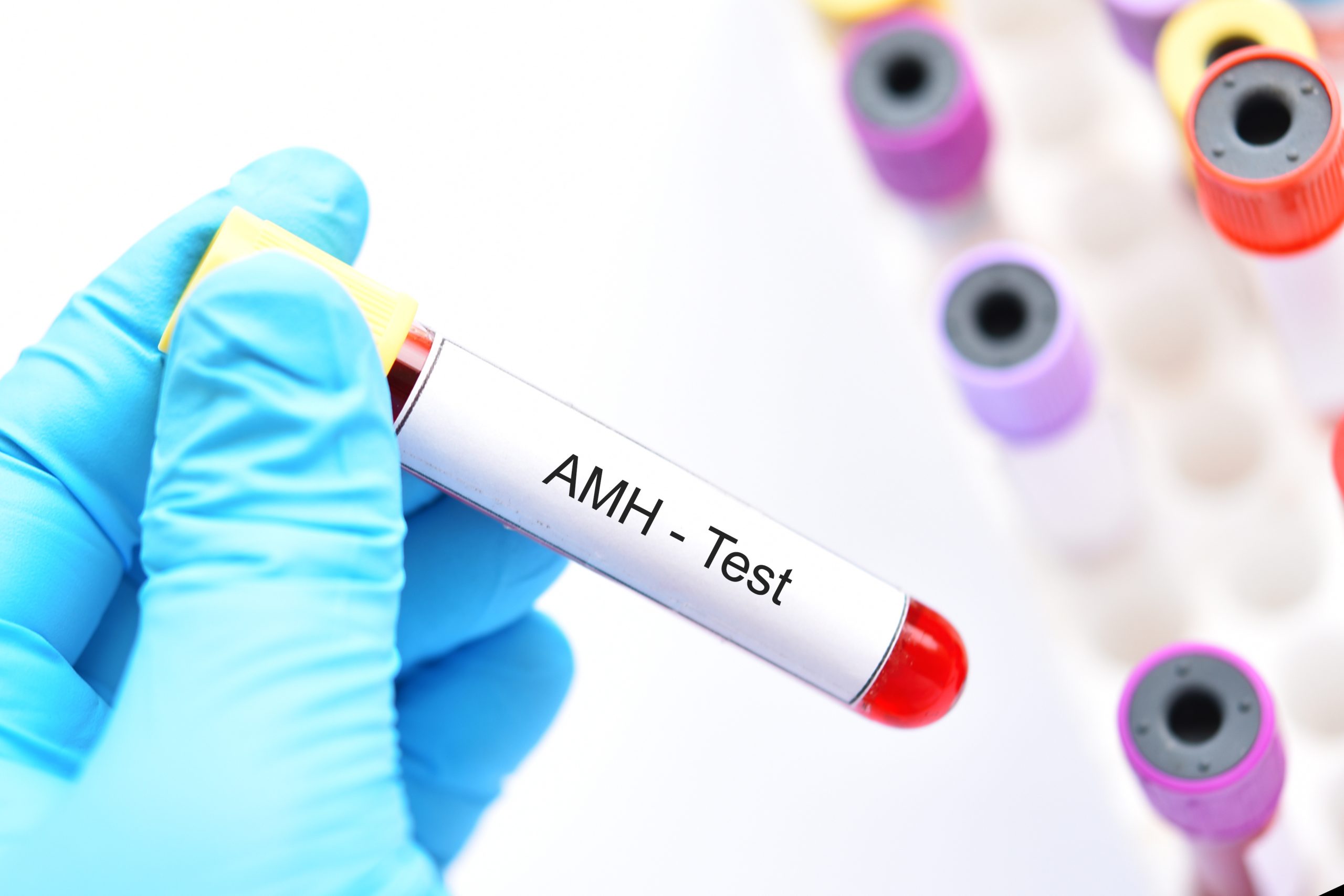IVF With Low AMH: Impacts and Protocols

Anti-Müllerian Hormone (AMH) is an indicator of ovarian reserve–the number and potentially the quality of healthy, immature eggs in a woman’s ovaries at any point in her life. Lower AMH levels often correlate with diminished fertility potential. This article explores the impacts that low AMH levels can have on in vitro fertilization (IVF) outcomes and what you can do about it.
What is the connection between AMH and IVF?
Anti-Müllerian hormone (AMH) levels in the blood offer a fairly accurate reflection of the number of secondary follicles containing oocytes (eggs).
Generally, treating patients with low AMH can be more challenging because low AMH corresponds with fewer retrieved eggs.3 The more eggs produced during stimulation and retrieval, the greater the likelihood of creating viable embryos to transfer. More viable embryos to transfer increase your overall IVF success rate.
That said, in some cases the opposite can also be true. Patients with very high AMH levels, for instance, those with PCOS, can overproduce oocytes but of poor quality, with a higher incidence of immature oocytes at retrieval leading to lower fertilization rates.
Results of a 2022 study looking at 665 women found that those with serum AMH levels of 1.10 ng/mL or higher had significantly more retrieved oocytes and better oocyte quality. This was associated with somewhat higher fertilization rates (but not statistically significant), higher embryo transfer rates (approaching statistical significance).
Research presented by by Richard Sherbahn, MD at the 69th Annual Meeting of the American Society for Reproductive Medicine, Boston, MA, October, 2013, found the following impacts of AHM levels on various stages along the IVF journey for women under 35.
AMH Level (ng/ml) | # of Cycles | Cancellation Rate | Mean # Eggs | Live Birth Rate Per Cycle |
<0.6 Low Group | 53 | 15.1% | 7.0 | 43.4% |
0.6-1.5 Middle Group | 188 | 3.7% | 9.3 | 43.6% |
>1.5 High Group | 545 | 0.4% | 14.2 | 63.9% |

IVF Protocols for Women with Low AMH
A 2013 study found low AMH levels predicted poor IVF outcomes. However, using the GnRH antagonist protocol was found to enhance pregnancy rates in low AMH patients.
GnRH antagonists work by inhibiting the brain from releasing Gonadotropin-releasing hormone, thereby stopping the pituitary gland from producing follicle-stimulating hormone (FSH) and luteinizing hormone (LH).
This mechanism allows fertility specialists to precisely manage egg development and schedule egg retrieval at the optimal moment, potentially enhancing the chances of successful treatment.

What Causes Low AMH
There are a number of factors that can cause low AMH, the most significant being your age.
Age and AMH
AMH naturally decreases with age–but even younger women (early <early 30s) can have low AMH.
However, in the context of IVF, younger women with low AMH may have a higher IVF success rate than older women with low AMH even if they produce the same low number of eggs.
In fact, a 2021 study found that the IVF live birth rate for younger patients with low AMH is equivalent to that of younger patients with normal AMH.
Low AMH is most significantly associated with lower live birth rates in women in their late 30s to early 40s. This is because as women age, the percentage of chromosomally abnormal eggs increases.
For example, of 10 eggs retrieved from a woman at 30, 7-8 will produce chromosomally normal embryos. Whereas only 2 of 10 eggs are likely to be chromosomally normal for a woman at 40.
Here are the general lower limit values of serum AMH by age, measured in nanograms per milliliter (ng/mL) :
- At age 45: 0.5 ng/mL
- At age 40: 1.0 ng/mL
- At age 35: 1.5 ng/mL
- At age 30: 2.5 ng/mL
- At age 25: 3.0 ng/mL

Source: Lee RK, Wu FS, Lin MH, Lin SY, Hwu YM. The predictability of serum anti-Müllerian level in IVF/ICSI outcomes for patients of advanced reproductive age. Reprod Biol Endocrinol. 2011
Other Factors that Can Cause Low AMH
Several other factors can contribute to low Anti-Müllerian Hormone (AMH) levels, which are indicative of a reduced ovarian reserve. Some of the main causes include:
- Genetics: Some women may have a naturally lower ovarian reserve due to genetic factors.
- Previous ovarian surgery: Surgeries such as cyst removal or treatment for endometriosis can reduce the number of follicles resulting in significant declines in AMH levels.
- Autoimmune disorders: Chronic autoimmune response, where the immune system attacks the body’s own tissues, can lower AMH levels, especially when the immune response occurs in or around the ovaries.
- Chemotherapy or radiation: Cancer treatments can damage ovarian tissue and reduce AMH levels.
- Smoking negatively impacts ovarian reserve, leading to lower AMH levels.
- Obesity: High body mass index (BMI) and metabolic disturbances can be associated with lower AMH levels.
- Endocrine disorders: Thyroid and adrenal disorders can affect ovarian function and AMH levels.
Additional Treatments for IVF with Low AMH?
Though AMH is largely a result of age and genetic factors, there are some steps you can take that may increase AMH, and protect and improve the quality of remaining eggs.
It is important to remember that even with lower AMH and fewer eggs, you can still have high quality eggs, which have the greatest impact on IVF success. For this reason fertility specialists recommend prioritizing your efforts towards increasing egg quality and not necessarily AMH levels and egg quantity.
Pre IVF preparation and stimulation protocols
Women with low AMH levels can increase their chances of IVF success by implementing a preconception protocol including:
- Regular low-impact movement practices like walking, cycling, swimming, and yoga.
- Limiting and/or eliminating alcohol, caffeine, and smoking.
- Supplementation with high-quality vitamins and compounds such as you find in Peak Prenatal, Ovarian Bloom, Immunoglobulin IgG , and VIVOMEGA Fish oil.
- Acupuncture and massage
General Supplementation and Tailored IVF Medications
DHEA, CoQ10, human growth hormone (HGH), and other fertility medications can help improve egg quality.
DHEA supplementation in particular, has been shown to directly improve IVF pregnancy rates.
Vitamin D supplementation has been shown to improve AMH levels in pre-menopausal women who were previously deficient in vitamin D.
Donor eggs
If egg quality or quantity is poor, a fertility specialist may suggest using donor eggs. The resulting embryo can then be transferred to the uterus.
Embryo freezing
Creating multiple embryos by fertilizing the egg with sperm and then freezing them for future use can mitigate complications and delays due to low AMH.
Exercise
Regular physical activity like yoga and pilates has been found to help maintain overall hormonal balance and reduce stress, which in turn can reduce inflammation–a key factor in ovary damage.
IVF with Low AMH: The Bottom Line
Anti-Müllerian Hormone (AMH) is used as an indicator of ovarian reserve–the number and potentially the quality of immature eggs in a woman’s ovaries. Lower AMH levels, common in women over 35, often indicate reduced fertility and can complicate IVF outcomes due to fewer retrieved eggs. However, younger women with low AMH may still achieve IVF success rates similar to peers with normal AMH, owing to better egg quality.
Common causes of low AMH include age, genetics, ovarian surgeries, autoimmune disorders, cancer treatments, smoking, obesity, and endocrine issues.
While AMH levels can’t be easily increased, lifestyle changes, supplements, exercise, acupuncture, and tailored medications can improve AMH and, more importantly, egg quality, which can improve overall IVF success. Options such as donor eggs and embryo freezing offer alternative solutions for those with low AMH. Despite the challenges of low AMH, successful IVF outcomes remain possible with appropriate strategies.



